For many who have gotten vaccinated or where lockdowns have eased, people are back in the office and readjusting to office life.
It’s time to take a good hard look at the meetings on your calendar and ask: What’s needed to move from virtual meetings back to the conference room?
Early in the pandemic, our customer’s calendars saw an increase in meetings, especially internal ones with their team, by more than 40% on average.
The surge in extra meetings makes sense. Teams that were formerly together had to move everything online.

If you’re like most people, you probably added meetings in 2020. 2021 is a great time to reduce the number if you are back in the conference room.
It may be worth reviewing how you did in-person meetings before the lockdown and “reverse” the changes—or better yet, take a fresh look based on people’s new habits.
First Call: A Retrospective on Meetings
Under most circumstances, you should never have a meeting about a meeting. Such a blunder usually indicates you’re not prepared.
This time it’s different.
An excellent first step for any recurring meeting you have is to add a quick retrospective to the agenda.
The first item should be a discussion of how the meeting itself has evolved during the WFH period and how it could be modified, shortened, or even eliminated now that you’re back in the office.
It makes sense to take 15 minutes on this for every regular meeting on your calendar. After all, if you shorten the meeting time, eliminate the meeting, or reduce its frequency, you’ll easily make that time back.
Even if it’s a meeting you had before COVID times, regular retrospectives on the process itself are among the ways companies innovate. Often overlooked, periodic reviews of the internal processes themselves are, in and of itself, a trajectory for innovation. Atlassian gave us some great tips for ongoing process improvement that you can check out.
Shorter and Fewer Meetings
Time spent in meetings is time away from producing work, so it’s worth reducing the amount of time spent in in-person meetings, conference calls, and virtual meetings if it’s not productive.
The two trajectories are reducing the number of meetings on your calendar and reducing the length of the meetings.
Not everyone can reduce their time to a 4-Hour Meeting Week like we do, but taking on the challenge at your company will force you to rethink what meetings are necessary. You’ll want to make meetings even more efficient than ever before.
Some simple hints for reducing meeting invites and meeting length include:
- Require all meetings to have an agenda and a purpose. Make it a company policy that any meetings without an agenda are automatically canceled.
- When the agenda items are covered, end the meeting. Just because you’ve got an hour set in the calendar doesn’t mean you need to fill the whole hour.
- Do follow-ups on the tasks and action items before the next meeting so that the team doesn’t have to rehash what happened in the previous meetings.
- Use asynchronous communication for status and routine updates.
- Create short templates and questionnaires for people to fill out prior to the meeting. Use simple and pointed questions such as “What’s one thing you’re stuck on this week?” or “What’s one area where you want feedback from the team?” or “What’s one big win you had this week?”
- Reserve meetings for areas that really need discussion, such as brainstorming, decision-making, perspective-gathering.
- Make sure that only the people who need to be in the meeting are invited.
- Offer people the option of coming only for the parts of the meeting that are relevant for them.
Async: Keep It Going
Working from home made all of us experts in asynchronous communications. E-mail, chat, voice, and asynchronous video platforms aren’t going anywhere. Maintain working practices that have helped your company function well during the period of remote work.

If an asynchronous method is working well, keep it in place. There may be a desire or temptation to move to in-person meetings but resist. Meetings are expensive.
The Human Side
On the upside, there are get-togethers you can add back. Group lunches, happy hours, and informal chats have always been an essential foundation of collaborative working.
For casual get-togethers, you may want to create fun icebreakers simply because it’s been so long since people were thrown into networking rooms together. Prompts for topics will also keep people’s minds off the pandemic and get them into a more creative mindset.
Another great benefit is that in-person brainstorming meetings can take advantage of movement, whether in a conference room or other venue. Studies have shown that moving around increases both creativity and retention. Brainstorming and planning using physical models, multiple whiteboards and posters, sticky notes, and other physical prompts can increase the creative space for brainstorming, planning, design, and strategy meetings.
You’ll also be able to go back to “going around the room” or using a physical “talking stick” to make sure everyone gets a turn to contribute. Nobody will miss that awkward scrolling on their screen to figure out whose turn it is to speak.
Wrapping It Up
Most importantly, as you come back to the office, make sure to take into consideration that people’s habits may have changed. Some of their non-verbal communication skills may be a bit rusty.
Several months at home may have spoiled you in terms of working in your pajamas, having your coffee exactly the way you like it, and having your own office or bathroom. Getting back to a shared space may include some minor irritations. When in doubt, just use the all-time classics: donuts or bagels for the morning meetings to warm up the environment and get everyone in a positive mood.
Don't let unproductive meetings slow you down
See the impact of fewer, shorter meetings, increased accountability, and enhanced productivity with Fellow.
Get started with Fellow today




